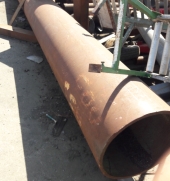posted 9 years ago
Just some thoughts that you can completely disregard if you wish, because I've never run a RMH. But I have used various wood stoves for 30+ years in cold winters.
1- as Byron pointed out, that's a long run from the burn chamber. Without a good drawing chimney, or a chimney fan, the fire may not burn for more than 5 to 10 minutes before refusing to draw. And getting initial draw may be difficult depending upon the fuel being used. The chimney will be losing a lot of heat in the mass area. (horizontal chimney). To expect it to lose more in the vertical chimney may shut down your draft.
2- because the exhaust gases will be quite cool by the time they reach the vertical chimney, if this was my stove I would extend the chimney further above the roof. Another 3' to 4' may help increase the draw.
3- since I've never run a RMH, I don't know if those horizontal pipes would need to be cleaned occasionally. If so, then I'd build it with clean out accesses so that a brush could be run down the pipes, followed by a vacuum hose or blower. Just a thought.
4- to prevent heat fatigue on the house structural wood, I would feel much better if I used the usual metal chimney collars where the vertical chimney passes through the floor, ceiling, roof. Even just a warm chimney can heat stress wood over the years.
5- I don't know the risk of a chimney fire with a RMH, but if someone were to fire it incorrectly, improper burning might occur. Therefore using an insulated vertical chimney may be cheap insurance to avoid the risk of a house fire due to chimney fire.
I experienced a chimney fire once simply because I didn't know how to properly maintain a fire in a large steel box stove. I surely did my homework after that because I almost set my roof on fire. A different house I lived in was heated by wood with no problem for 10 years, but the new owners after us promptly set the chimney afire their first winter. So chimney fires can happen with correct installation all because somebody unknowingly misfired the stove.
It's never too late to start! I retired to homestead on the slopes of Mauna Loa, an active volcano. I relate snippets of my endeavor on my blog : www.kaufarmer.blogspot.com







